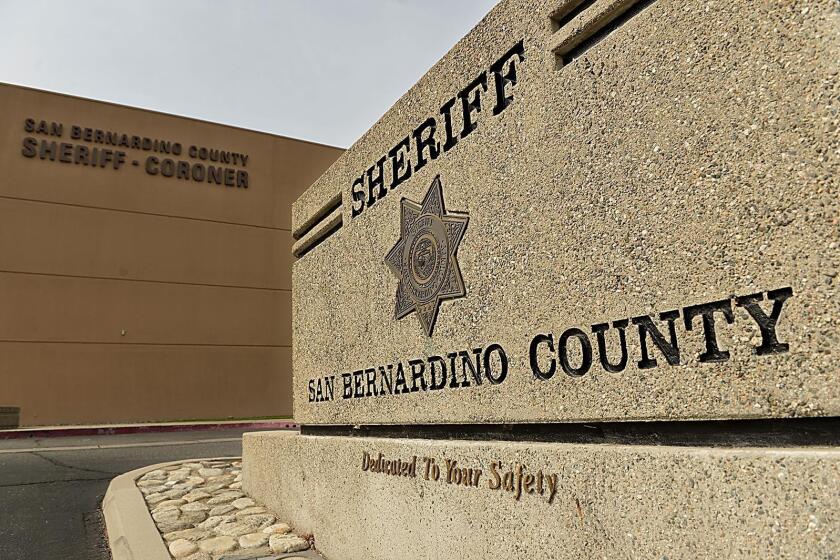Column: Rats at the police station, filth on L.A. streets — scenes from the collapse of a city that’s lost control
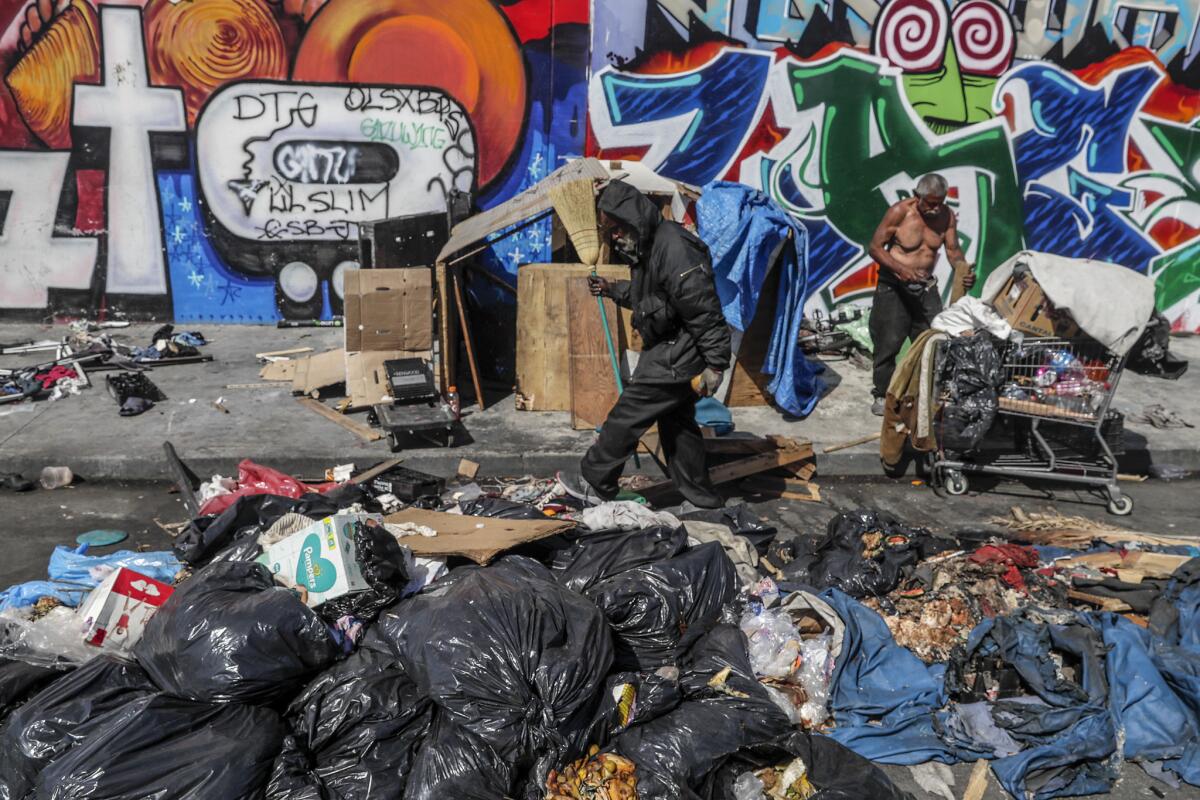
- Share via
The good news is that two trash-strewn downtown Los Angeles streets I wrote about last week were cleaned up by city work crews and have been kept that way, as of this writing.
The bad news is that I didn’t have to travel far to find more streets just as badly fouled by filthy mounds of junk and stinking, rotting food.
Then there was the news that the LAPD station on skid row was cited by the state for a rodent infestation and other unsanitary conditions, and that one employee there was infected with the strain of bacteria that causes typhoid fever.
What century is this?
Is it the 21st century in the largest city of a state that ranks among the world’s most robust economies, or did someone turn back the calendar a few hundred years?
RELATED: How downtown L.A. got so filthy
We’ve got thousands of people huddled on the streets, many of them withering away with physical and mental disease. Sidewalks have disappeared, hidden by tents and the kinds of makeshift shanties you see in Third World places. Typhoid and typhus are in the news, and an army of rodents is on the move.

L.A. Times columnist Steve Lopez roams Greater Los Angeles with Times photographer Francine Orr and videographer Albert Lee and describes a scene of despair among the homeless.
On Thursday I saw a county health inspector on rat patrol between 7th and 8th streets on skid row. He was carrying a clipboard and said he had found droppings and other evidence of rodents, and I asked where:
“Everywhere,” he said.
Well, it’s nice to know somebody is doing something, but you don’t need a clipboard. I’ve seen so many rats the last two weeks in downtown Los Angeles, I have to suspect they’re plotting a takeover of City Hall, which vermin infiltrated last year.
The city of Los Angeles has become a giant trash receptacle. It used to be that illegal dumpers were a little more discreet, tossing their refuse in fields and gullies and remote outposts.
Now city streets are treated like dumpsters, or even toilets — on Thursday, the 1600 block of Santee Street was cordoned off after someone dumped a fat load of poop in the street. I’m not sure when any of this became the norm, but it must have something to do with the knowledge that you can get away with it. Every time sanitation crews knock down one mess, another dumpsite springs up nearby.
You wanna take a tour with me of how things looked Wednesday and Thursday?
OK, the shovels were still out on Crocker Street, which was looking pretty good, so I went over to East 10th Street and Naomi Avenue, several blocks away, near the Coca-Cola distribution center.
The north side of 10th Street looked like a landfill. Trash was scattered in the street and on the sidewalk, and there was a little bit of everything. Splintered lumber, metal poles, soiled blankets and clothing, a sofa, buckets, boxes.
“Trucks come by and run over the trash,” said Ron Riego, 60, who lives under a tarp on the corner and pointed out where some of the debris has been flattened by traffic.
Riego said he was just back from the hospital, where he was treated for congestive heart failure and water on the lungs. On returning to his tarp, he discovered that someone had set fire to some of his belongings. Now he was sorting through his things to see what was salvageable, and planning to move a few feet to the west.
“Rats chased me out,” he said, so he was surrendering his lean-to to the rodents.
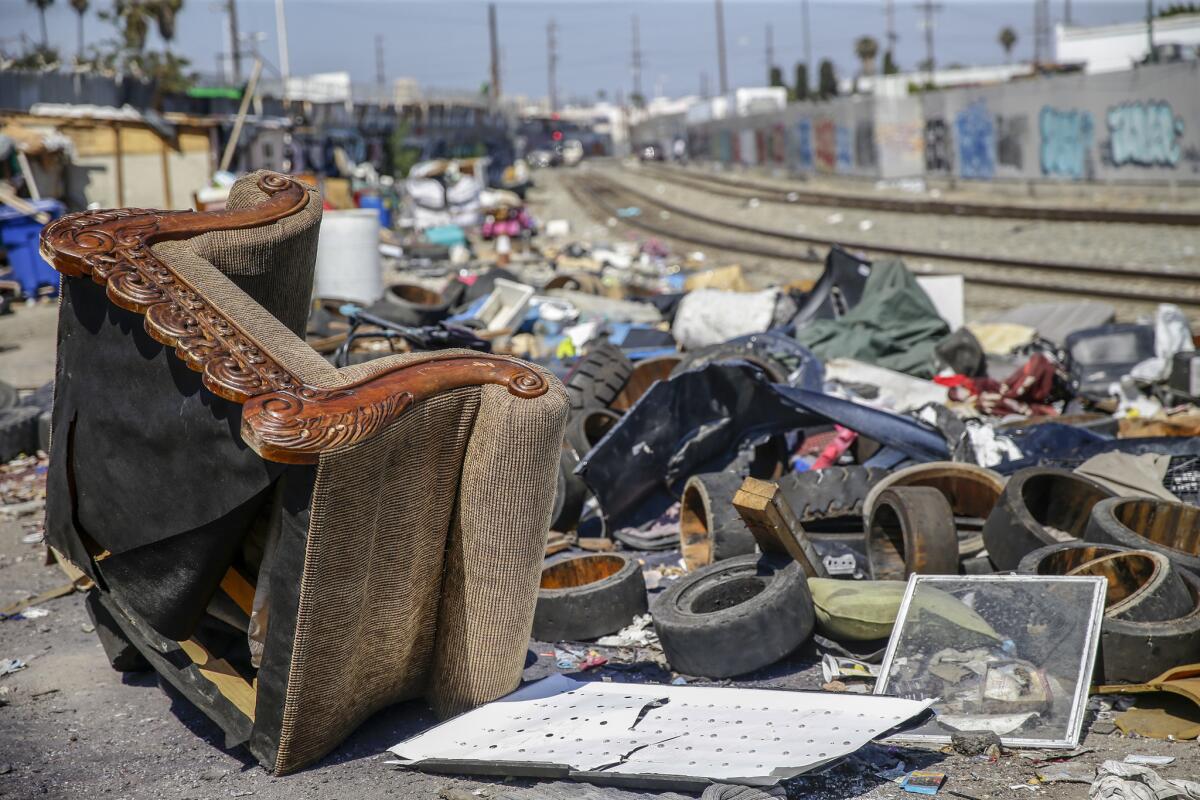
“Someone came by in the middle of the night and dropped all those bags,” Riego said, telling me such dumps were common. “I looked out and saw a nice new white pickup truck stop and toss everything, then he took off,” he said.
The bags, some of which were split open, contained spoiled fruit and trimmings from pineapples and mangoes. That part of town has a lot of produce wholesalers, and it’s no secret that some of the illegal dumping is done by local merchants and customers. Nor is it any secret that food scraps attract rats.
At East 16th Street and Compton Avenue, just south of the 10 Freeway, trash billowed at the corner and tapered gradually to the east along a building tagged with graffiti. The debris included boxes, bulging trash bags and a crushed Lime scooter. The centerpiece was a heaping shopping cart.
RELATED: Homeless camps’ feces and other filth lure rats to City Hall, report says »
I saw a few encampments nearby and standing, murky green water in the gutters. Were the drains clogged with trash? Is a water or sewer line leaking? You just never know, and you almost don’t want to think about it. I go through a lot of antibacterial wipes after a day here, and I take my shoes off before I enter my house. It’s horrifying to think about how many people live in the middle of all that muck.
I went back to 16th and Compton the next day to find a city crew cleaning up the mess, and I spoke to James Campbell, who runs the uniform rental company on that corner.
“I call the city and they usually come within a week, but then it’s always piled right back up again,” said Campbell.
“I don’t even like stepping out here because of the needles,” said Campbell, who told me he cringes when customers come to his office and witness what’s at his doorstep.
“It’s embarrassing,” he said.
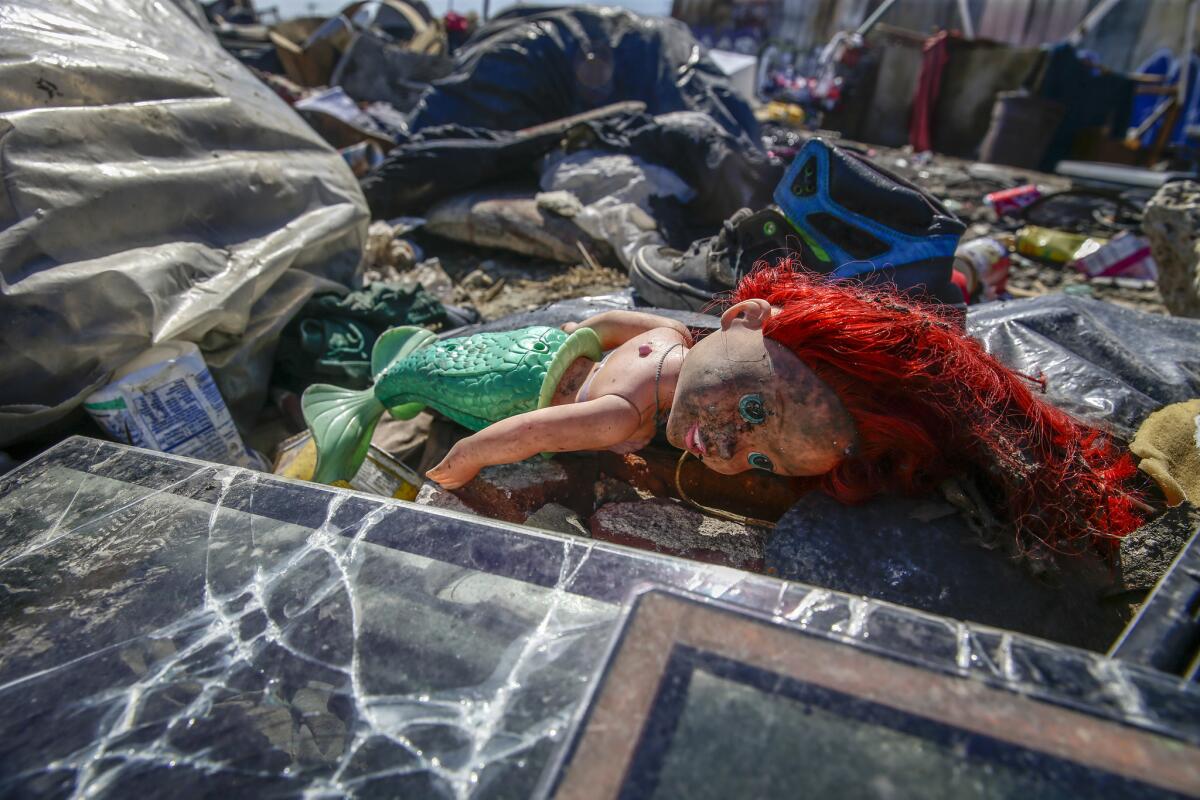
Yes, but it’s not Campbell who should be embarrassed. It’s L.A. Mayor Eric Garcetti and the 15 members of the City Council who run the city and have not responded with the urgency necessary to deal with the homelessness and trash problems that plague Los Angeles.
They alone did not create the social and economic woes that have contributed to the city’s major problems, and it’s not as if they’ve been completely unresponsive. About 27,000 people were housed last year, for instance. But even more people have ended up in their cars and on streets and riverbeds, and taxpayers are right to wonder why City Hall keeps losing its most important battles.
When I called Councilman Jose Huizar’s office about the trash piled on Ceres Avenue, a staffer told me issues like that are complaint-driven, and if no one has called, the office might not know the problem exists.
What, they don’t have eyes?
Look, I know Huizar might be a little distracted, given that the FBI has hauled records out of his home and office as part of a City Hall corruption probe, and the councilman has other legal problems too.
But council districts have as many as two dozen employees and in times of crisis they ought to have more than a few of them in the field, spotting and solving problems, and cracking down on illegal dumpers. Not just with citations, but with handcuffs, perp walks and mandatory trash pickup duty.
The city has thousands of workers on the streets every day writing tickets, fixing potholes, driving trash trucks. Every one of them ought to be reporting issues they see on their rounds.
“If you’re writing a parking ticket and someone dumps a toilet in the street, you should call sanitation,” said Estela Lopez of the Downtown Industrial Business Improvement District, or BID.
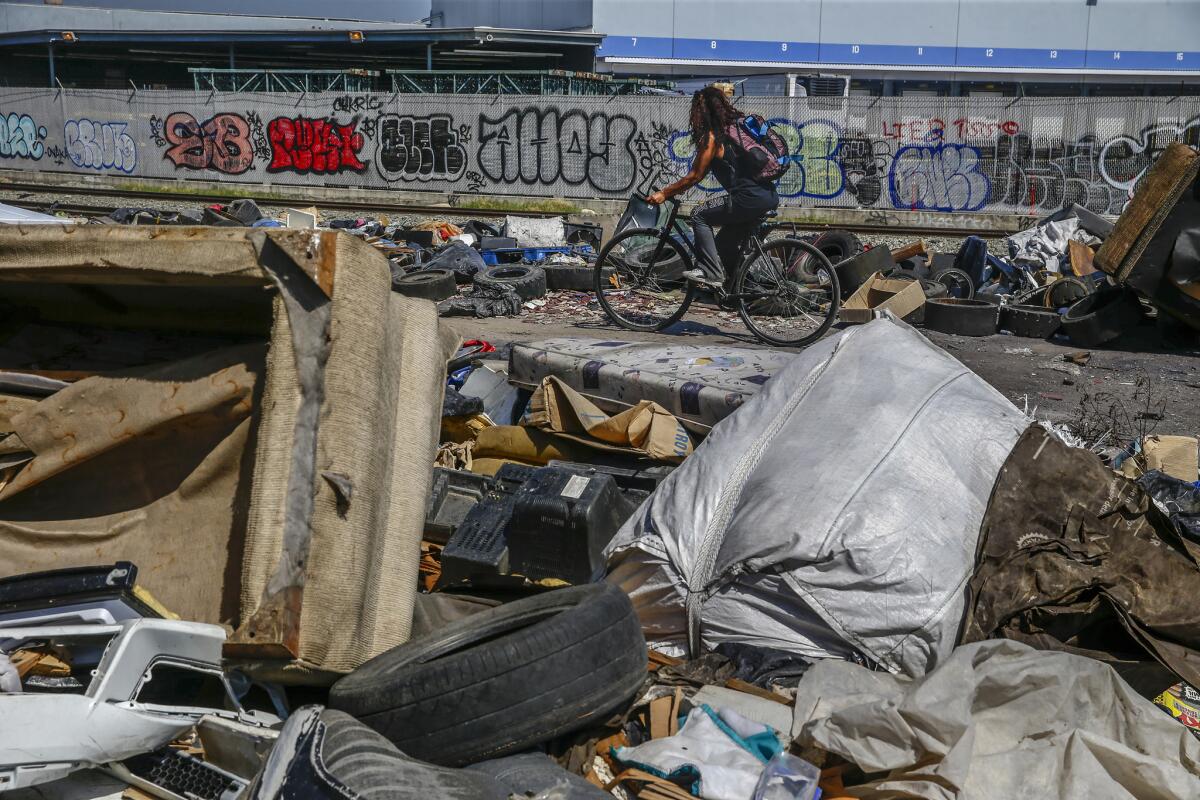
The crews that clean the streets of that BID are homeless or formerly so, and they’re employed by the nonprofit Chrysalis, which tries to get them all housed and self-supporting. James Blackwell, for instance, supervises Lopez’s crew and told me he just moved into his own place.
It’s a terrific program — clean the streets and get people off the streets at the same time. Chrysalis staffs 16 BIDs in L.A. and 10 Caltrans crews, and would like to do more. But an expansion proposal has gotten bottled up at City Hall. Stay tuned for more on that in the near future.
Meanwhile, let’s keep the pressure on City Hall.
I drove a little farther south Thursday and found a monumental dumpsite at East 25th Street and Long Beach Avenue along the railroad tracks. I took photos during my survey to share with City Hall, and I’d like you to do the same.
Get your camera or phone and send me photos of eyesores in your neighborhood or near your place of employment. Include the address, and I’ll take a look at as many as I can get to, publicize the filth and count the days until City Hall cleans it up.
If we don’t take charge, who will?
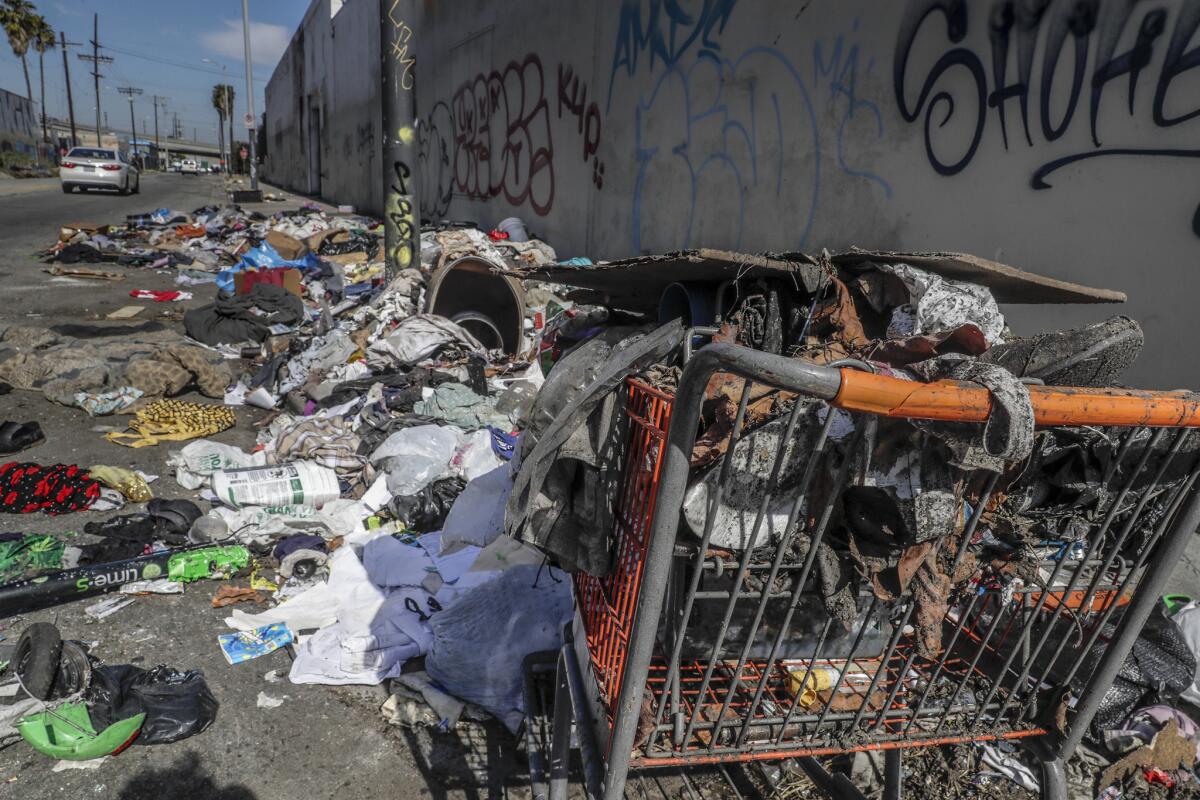
Get more of Steve Lopez’s work and follow him on Twitter @LATstevelopez
More to Read
Sign up for Essential California
The most important California stories and recommendations in your inbox every morning.
You may occasionally receive promotional content from the Los Angeles Times.





